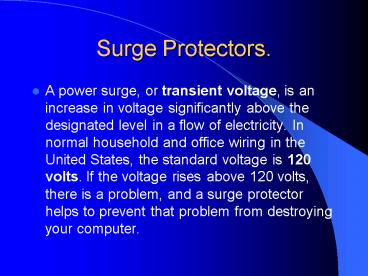Surge Protectors. - PowerPoint PPT Presentation
1 / 9
Title:
Surge Protectors.
Description:
In normal household and office wiring in the United States, the standard voltage ... If the voltage rises above 120 volts, there is a problem, and a surge protector ... – PowerPoint PPT presentation
Number of Views:796
Avg rating:3.0/5.0
Title: Surge Protectors.
1
Surge Protectors.
- A power surge, or transient voltage, is an
increase in voltage significantly above the
designated level in a flow of electricity. In
normal household and office wiring in the United
States, the standard voltage is 120 volts. If the
voltage rises above 120 volts, there is a
problem, and a surge protector helps to prevent
that problem from destroying your computer.
2
Surge Protector
A simple MOV surge protector with line
conditioning and a fuse.
3
- A standard surge protector passes the electrical
current along from the outlet to a number of
electrical and electronic devices plugged into
the power strip. If the voltage from the outlet
surges or spikes -- rises above the accepted
level -- the surge protector diverts the extra
electricity into the outlet's grounding wire. - In the most common type of surge protector, a
component called a metal oxide varistor, or MOV,
diverts the extra voltage. - As soon as the extra current is diverted into the
MOV and to ground, the voltage in the hot line
returns to a normal level, so the MOV's
resistance shoots up again. In this way, the MOV
only diverts the surge current, while allowing
the standard current to continue powering
whatever machines are connected to the surge
protector. Metaphorically speaking, the MOV acts
as a pressure-sensitive valve that only opens
when there is too much pressure.
4
Voltage Regulators
- A voltage regulator is an electrical regulator
designed to automatically maintain a constant
voltage level. - Eg. Tripp Lite Line Conditioner LS606M Automatic
Voltage Regulation with surge protection has 6
outlets. Automatic voltage regulation system
offers complete protection from brownouts,
overvoltages and transient surges for computers,
printers, fax machines and more.
5
Uninterruptible Power Supply (UPS)
- An acronym for uninterruptible power
source/supply. A UPS is primarily used as a back
up power source for computers and computer
networks to ensure on-going operation in the
event of a power failure. Sophisticated units
also have power conditioning and power monitoring
features. - Typically, a UPS keeps a computer running for
several minutes after a power outage, enabling
you to save data that is in RAM and shut down the
computer gracefully. Many UPSs now offer a
software component that enables you to automate
backup and shut down procedures in case there's a
power failure while you're away from the computer.
6
- A UPS generally protects a computer against four
- different power problems
- Voltage surges and spikes - Times when the
voltage on the line is greater than it should be - Voltage sags - Times when the voltage on the line
is less than it should be - Total power failure - Times when a line goes down
or a fuse blows somewhere on the grid or in the
building - Frequency differences - Times when the power is
oscillating at something other than 60 Hertz
7
- There are two common systems in use today
- standby UPS - runs the computer off of the normal
utility power until it detects a problem. At that
point, it very quickly (in five milliseconds or
less) turns on a power inverter and runs the
computer off of the UPS's battery. A power
inverter simply turns the DC power delivered by
the battery into 120-volt, 60-Hertz AC power.
Standby UPS systems are far more common for home
or small-business use because they tend to cost
about half as much as a continuous system. - continuous UPS - the computer is always running
off of battery power and the battery is
continuously being recharged. There is no
switch-over time in a continuous UPS. This setup
provides a very stable source of power.
Continuous systems provide extremely clean,
stable power, so they tend to be used in server
rooms and mission critical applications.
8
(No Transcript)
9
(No Transcript)

